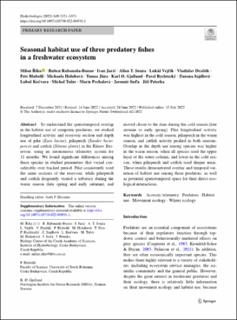Seasonal habitat use of three predatory fishes in a freshwater ecosystem
Říha, Milan; Rabaneda-Bueno, Ruben; Jarić, Ivan; Souza, Allan T.; Vejřík, Lukáš; Draštík, Vladislav; Blabolil, Petr; Holubová, Michaela; Jůza, Tomas; Gjelland, Karl Øystein; Rychtecký, Pavel; Sajdlová, Zuzana; Kočvara, Luboš; Tušer, Michal; Prchalová, Marie; Seďa, Jaromír; Peterka, Jiří
Peer reviewed, Journal article
Published version

Åpne
Permanent lenke
https://hdl.handle.net/11250/3054510Utgivelsesdato
2022Metadata
Vis full innførselSamlinger
- Publikasjoner fra CRIStin - NINA [2364]
- Scientific publications [1392]
Sammendrag
To understand the spatiotemporal overlap in the habitat use of sympatric predators, we studied longitudinal activity and reservoir section and depth use of pike (Esox lucius), pikeperch (Sander lucioerca) and catfsh (Silurus glanis) in the Římov Reservoir, using an autonomous telemetry system for 11 months. We found signifcant diferences among these species in studied parameters that varied considerably over tracked period. Pike consistently used the same sections of the reservoir, while pikeperch and catfsh frequently visited a tributary during the warm season (late spring and early autumn), and moved closer to the dam during the cold season (late autumn to early spring). Pike longitudinal activity was highest in the cold season, pikeperch in the warm season, and catfsh activity peaked in both seasons. Overlap in the depth use among species was higher in the warm season, when all species used the upper layer of the water column, and lower in the cold season, when pikeperch and catfsh used deeper areas. These results demonstrated overlay and temporal variation of habitat use among these predators, as well as potential spatiotemporal space for their direct ecological interactions. Acoustic telemetry · Predators · Habitat use · Movement ecology · Winter ecology
